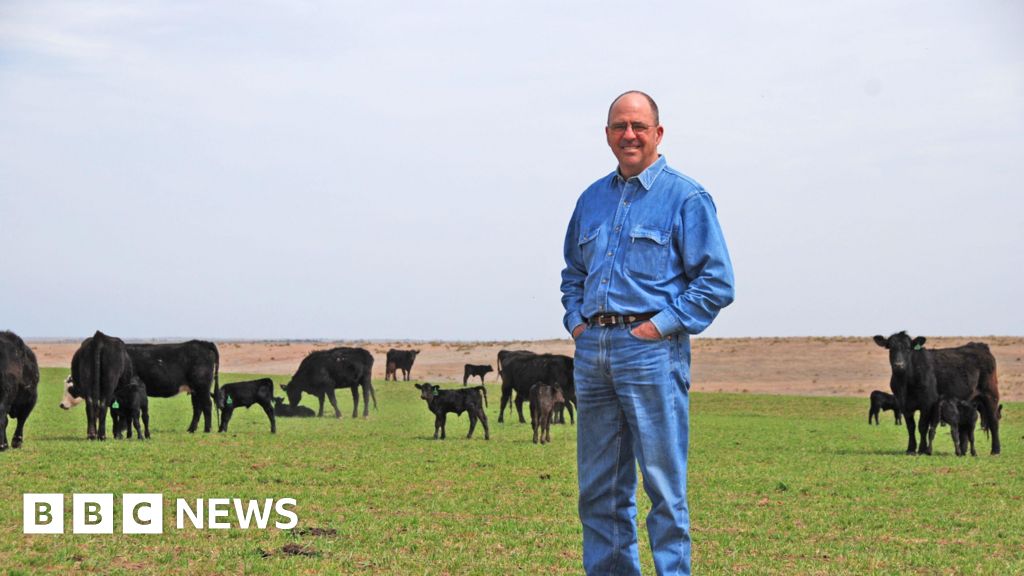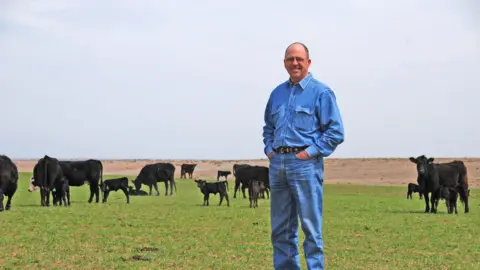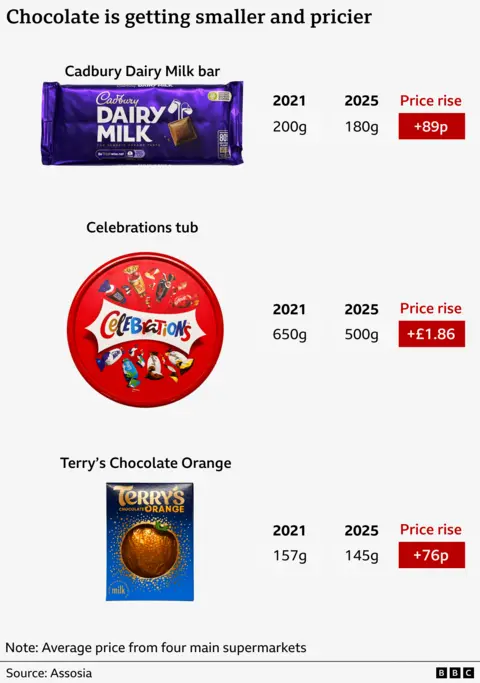Business
US beef prices are soaring. Will Trump’s plans lower them?

Danielle KayeBusiness reporter
 Mike Callicrate
Mike CallicrateBeef prices have gotten so high in the US that it has become a political problem.
Even US President Donald Trump, who long ago declared inflation “dead”, is talking about it, as the issue threatens to undercut his promises to bring down grocery prices for Americans.
This week, he took to social media, urging ranchers to lower prices for their cattle.
But his demand – and other proposals his administration has floated to address the issue – has sparked a backlash among ranchers, who worry some of his solutions will make it harder for them to make a living, while making little dent at the grocery store.
The number of beef cattle farmers and ranchers in the US has dwindled steadily since 1980, reducing domestic supplies and driving up prices, as demand remains high.
The country’s cattle inventory has fallen to its lowest level in nearly 75 years, while the US has lost more than 150,000 cattle ranches since 2017 – a 17% drop, according to the Agriculture Department.
Ranchers say they are under pressure from four decades of consolidation among the meat processors that buy their livestock, while high costs for key inputs like fertiliser and equipment have intensified the strain.
The contraction in the industry has worsened as several years of drought have forced ranchers to slash their herd sizes.
Christian Lovell, a cattle rancher in Illinois, says parts of his farm that were lush and grassy when he was a child have now dried up, limiting where his cows can graze.
“You put all these together and you have a recipe for a really broken market,” says Mr Lovell, who works with advocacy group Farm Action.
Beef inflation
Retail prices for beef mince rose 12.9% in the 12 months to September, and beef steaks were up 16.6%, according to US inflation data published on Friday by the Bureau of Labor Statistics.
A pound of ground chuck – richer mince from the neck and shoulder of cows – now costs an average of $6.33 (£4.75), compared to $5.58 a year ago.
The increases have significantly outpaced general food inflation, which stood at 3.1%.
“The cattle herd has been getting smaller for the last several years, yet people are still wanting that American beef – hence the high prices,” says Brenda Boetel, a professor of agricultural economics at the University of Wisconsin, River Falls.
Derrell Peel, a professor of agricultural economics at Oklahoma State University, says he expected prices to remain elevated until at least the end of the decade, noting that it takes years to replenish herds.
The Trump administration’s “hands are tied” when it comes to interventions that will help lower prices, he adds.
 Reuters
Reuters‘Chaos’ for US producers
The Agriculture Department unveiled what it called a “big package” this week aimed at ramping up domestic beef production by opening more land for cattle grazing and supporting small meat processors.
That proposal came after Trump drew the ire of ranchers when he proposed importing more beef from Argentina, potentially quadrupling US purchases.
Eight House Republicans responded with a letter expressing concerns about the plans.
Even the National Cattlemen’s Beef Association, which has voiced support for Trump’s policies in the past, said the import plan “only creates chaos at a critical time of the year for American cattle producers, while doing nothing to lower grocery store prices”.
Trump responded by assuring farmers that he was helping them in other ways, noting that tariffs that were limiting imports from Brazil.
“It would be nice if they would understand that, but they also have to get their prices down, because the consumer is a very big factor in my thinking, also,” Trump wrote.
But that has failed to quell the furore.
Justin Tupper, president of the US Cattlemen’s Association, says only the big four meat packers would benefit from Trump’s import plan in his view.
“I don’t see that lowering prices here at all,” he says.
‘These are consolidated markets’
Some say the US government could make an impact if it focused on the way a handful of companies dominate the market for meat processing.
Today, just four firms control more than 80% of the beef slaughtering and packing market.
“These are consolidated markets gouging ranchers and gouging consumers at the store,” said Austin Frerick, an agricultural and antitrust policy expert and a fellow at Yale University.
The meat processing firms – Tyson, JBS, Cargill and National Beef – have faced several lawsuits, including one filed by McDonald’s alleging that they colluded to inflate the price of beef.
Though Trump revoked a Biden-era order earlier this year directing agencies to tackle corporate consolidation across the food supply chain, his administration has taken other steps to investigate competition issues in the agricultural industry.
‘We’re not going to rebuild this cow herd’
Mike Callicrate runs a cattle ranch in St Francis, Kansas. He says the only way he has managed to stay in the industry was by cutting out the middleman and setting up his own stores to reach consumers directly.
But he acknowledged that most ranchers do not have the money to make that shift. Many have left the industry – and see no incentive to jump back in.
“We’re not going to rebuild this cow herd – not until we address market concentration,” Mr Callicrate says.
He adds that he supported the Agriculture Department’s plans to open up more cattle grazing land.
“But unless we have a market”, anyone would be a “fool to get into the cattle business”, he says.
 Bill Bullard
Bill BullardBill Bullard found himself in the first wave of ranchers pushed out as the meat processing industry started to consolidate in the early 1980s.
He closed down his 300-cow operation in South Dakota in 1985.
Now the chief executive of R-CALF USA, a cattle producer trade association, he says it was only in the last year or so that ranchers had received good prices for their livestock, as supply dropped to such a low level that the prices paid by meat processors “simply had to increase”.
Still, reliance on imports and meat packers’ buying power persists, Mr Bullard says, meaning ranchers “lack confidence in the integrity of the marketplace” and remain reluctant to grow their herds.
He says he does not have confidence that the president’s ideas would fix the issues.
“He’s focused on the symptoms and not the problems.”
Business
Christmas gifts wrapped for children across London

Matt Gravellingin Barking and Dagenham
 BBC
BBCMore than 100 volunteers have gathered in an east London community hall to wrap thousands of Christmas presents for children across the capital, with organisers saying for some, it would be the only gift they would get this year.
The Kindness Offensive, a charity that redistributes donated goods to schools, food banks and community groups, was behind the gift drive.
David Goodfellow, the event’s organiser, said the project was focused on children from families facing hardship.
“For a lot of the children we are helping today, what they get from this project, what they get from the Kindness Offensive, is going to be the only thing they get for Christmas,” he said.
The gifts were donated by companies before being wrapped and loaded onto a red bus for delivery across the capital.
One volunteer said the event was about more than presents, and more about giving children hope.
Another woman said the event was a way to end the year “on a high”.

Dominic Twomey, leader of Barking and Dagenham Council, said child poverty remained a serious issue in the borough.
“We have four in 10 of our children under the age of 16 living in poverty,” he said, and added the gifts helped ease pressure on parents at a difficult time of year.
The bus delivering the presents made a stop at Becontree Primary School in Dagenham on Wednesday.
Pupils there did not know a surprise was waiting for them, said head teacher Marie Ziane.

“Not one of them who are going to come into the hall know about this,” she said.
“I’m really looking forward to the surprise on their faces.”
Organisers said the aim of the Kindness Offensive was to ensure no child felt forgotten at Christmas, particularly as families continue to struggle with the cost of living.
Volunteers said they hoped the gifts would bring some joy to children who might otherwise go without.
Business
Petrol, Diesel Fresh Prices Announced: Check Rates In Your City On December 13

Last Updated:
Petrol, Diesel Price On December 13: Check City-Wise Rates Across India Including In Delhi, Mumbai and Chennai.

Petrol, Diesel Prices On December 13.
Petrol and Diesel Prices on December 13, 2025: OMCs update petrol and diesel prices daily at 6 am, aligning them with fluctuations in global crude oil prices and currency exchange rates. This daily revision promotes transparency and ensures consumers have access to the most up-to-date and accurate fuel prices.
Petrol Diesel Price Today In India
Check city-wise petrol and diesel prices on December 13:
| City | Petrol (₹/L) | Diesel (₹/L) |
|---|---|---|
| New Delhi | 94.72 | 87.62 |
| Mumbai | 104.21 | 92.15 |
| Kolkata | 103.94 | 90.76 |
| Chennai | 100.75 | 92.34 |
| Ahmedabad | 94.49 | 90.17 |
| Bengaluru | 102.92 | 89.02 |
| Hyderabad | 107.46 | 95.70 |
| Jaipur | 104.72 | 90.21 |
| Lucknow | 94.69 | 87.80 |
| Pune | 104.04 | 90.57 |
| Chandigarh | 94.30 | 82.45 |
| Indore | 106.48 | 91.88 |
| Patna | 105.58 | 93.80 |
| Surat | 95.00 | 89.00 |
| Nashik | 95.50 | 89.50 |
Key Factors Behind Petrol and Diesel Rates
Petrol and diesel prices in India have remained unchanged since May 2022, following tax reductions by the central and several state governments.
Oil Marketing Companies (OMCs) update fuel prices daily at 6 am, adjusting for fluctuations in global crude oil markets. While these rates are technically market-linked, they are also influenced by regulatory measures such as excise duties, base pricing frameworks, and informal price caps.
Key Factors Influencing Fuel Prices in India
-
Crude Oil Prices: Global crude oil prices are a primary driver of fuel prices, as crude is the main input in petrol and diesel production.
-
Exchange Rate: Since India relies heavily on crude oil imports, the value of the Indian rupee against the US dollar significantly affects fuel costs. A weaker rupee typically translates to higher prices.
-
Taxes: Central and state-level taxes constitute a major portion of retail fuel prices. Tax rates vary across states, leading to regional price differences.
-
Refining Costs: The cost of processing crude oil into usable fuel impacts retail prices. These costs can fluctuate depending on crude quality and refinery efficiency.
-
Demand-Supply Dynamics: Market demand also influences fuel pricing. Higher demand can push prices up as supply adjusts to consumption trends.
How to Check Petrol and Diesel Prices via SMS
You can easily check the latest petrol and diesel prices in your city through SMS. For Indian Oil customers, text the city code followed by “RSP” to 9224992249. BPCL customers can send “RSP” to 9223112222, and HPCL customers can text “HP Price” to 9222201122 to receive the current fuel prices.
December 13, 2025, 07:46 IST
Read More
Business
Why your chocolate is getting smaller, more expensive and less chocolatey

Archie MitchellBusiness reporter
 Getty Images
Getty ImagesCrack open a tub of Celebrations or pull a Terry’s Chocolate Orange from a stocking these days, and have you noticed, there seems to be a little less to go around?
Not only that, you might find – no, it is not your imagination – that some popular treats taste a little different, a little less “chocolatey”.
To top it all the prices have risen too.
So will your festive favourites still hit the sweet spot this Christmas?
Chocs away
Many of the companies making popular bars and chocolates admit they have been looking for ways to save money. A tried-and-tested one is to replace some of the more expensive ingredients, like cocoa, with cheaper ones, a strategy that’s been dubbed “skimpflation”.
Some recipes have changed so much that bars like Toffee Crisp, Penguin and others can no longer be called chocolate.
There is even a debate among some chocolate fans over whether the year-round classic Cadbury’s Dairy Milk has changed its recipe.
Becca Amy Stock, a TikTok influencer who goes by the name Becca Eats Everything, set herself the task of reviewing every milk chocolate bar at Britain’s major supermarkets. The 29-year-old spent six hours and £100 on her rigorous research.
She concluded Dairy Milk was “more oily” since Cadbury’s takeover by the American company Mondelez in 2010. And the brand, famous for its “glass and a half” of milk, was less milky, she said.
“You do notice the difference,” Becca says, “Cadbury’s does not taste how it used to taste.”
 Becca Amy Stock
Becca Amy StockMilk chocolate in the UK must have at least 20% cocoa solids and 20% milk solids to earn the name chocolate. Without that it has to be labelled “chocolate flavour” not chocolate. Cadbury’s Dairy Milk still meets that standard.
Mondelez says it has not been fiddling with the recipe, at least not recently.
“Our Cadbury Dairy Milk products continue to be made with the same delicious recipes that consumers know and love,” its spokesperson said. “The cocoa content has not changed for many years.”
Crunching the numbers
But it is still one which you’ll be paying more for.
Plenty of food manufacturers have been reducing the size of their products, without dropping prices, known as shrinkflation.
And some are also putting prices up, too.
Chocolate prices in supermarkets have risen by more than 18% on average from this time last year, according to market researchers Kantar.

We got these figures by analysing price data collected by market researchers Assosia across four of the UK’s biggest grocers, Tesco, Sainsbury’s, Asda and Morrisons, between December 2021 and December 2025.
They show:
- Cadbury’s Dairy Milk weighs 10% less, while the cost jumped from £1.86 to £2.75 – a 48% price increase
- Mars Celebrations has shrunk by 23%. The price has risen from £4.25 to £6.11 – a 44% jump
- Terry’s Chocolate Orange is 8% smaller, while the cost has risen from £1.49 to £2.25 – a 51% price rise
 Getty Images
Getty ImagesMondelez’s spokesperson said putting up prices was a “last resort” but ingredients are costing more – in particular cocoa and dairy.
“This means our products continue to be much more expensive to make.
“As a result of this difficult environment, we have had to make the decision to slightly reduce the weight and increase the list price of some of our Cadbury products,” they said.
Mars Wrigley told the BBC higher cocoa prices and manufacturing costs meant they had to “adjust some… product sizes… without compromising on quality or taste.”
Sticky costs
So what has caused the price of cocoa and milk to shoot up?
Extreme weather caused by climate change has hit cocoa farmers’ crop yields in Africa, says Ghadafi Razak, an academic at Warwick Business School.
Extreme rainfall in India, Brazil and Thailand in 2023, followed by droughts the following year have meant poor harvests in those countries too, pushing up prices.
The extra costs take time to feed through to customers, says Christian Jaccarini, a senior food analyst at the Energy & Climate Intelligence Unit think tank, which means those extra costs are hitting shop shelves now.
“It takes about 18 months for the impact of a shock to be felt by consumers, so we still have quite a long time with higher prices for chocolate,” he said.
Milk prices have shot up too. Diarmaid Mac Colgáin, founder of the Concept Dairy consultancy blames the rising cost of feed, fuel and fertilisers as well as farmers facing higher wage bills and production costs.
He says some brands have substituted palm oil and shea oil for some of the milk to make up the fat content of their chocolate.
Bad taste
Shoppers are becoming increasingly aware of these cost-saving tactics, but that does not mean they are happy about it.
It is the element of unwanted surprise that can leave a bad taste, according to Reena Sewraz, retail editor at consumer champion, Which?
It can feel “especially sneaky” when companies shrink products or downgrade their ingredients she said.
“With Christmas not far away, shoppers will be looking to get the best value from what they buy,” she said. “Supermarkets and manufacturers should be more upfront about making these changes. Customers may not love the news – but [then] at least they don’t feel misled.”
 Alamy
AlamyBut there is not much you can do about it. For Becca, who insists she’s not “chocolated out” despite her chocolate-tasting marathon, quality not quantity is the way to go.
She suggests fellow chocoholics treat themselves to smaller premium bars such as Tony’s Chocolonely. They’ll cost more but she finds them more satisfying.
She also plans to treat herself to a selection-box on Christmas day.
Otherwise she generally advises against “food snobbery”.
“I think supermarket own-brands are actually a much better way to get better quality chocolate.”
-

 Politics5 days ago
Politics5 days agoThailand launches air strikes against Cambodian military: army
-

 Sports1 week ago
Sports1 week agoAustralia take control of second Ashes Test | The Express Tribune
-

 Politics6 days ago
Politics6 days ago17 found dead in migrant vessel off Crete: coastguard
-

 Fashion5 days ago
Fashion5 days agoGermany’s LuxExperience appoints Francis Belin as new CEO of Mytheresa
-

 Tech1 week ago
Tech1 week agoWIRED Roundup: DOGE Isn’t Dead, Facebook Dating Is Real, and Amazon’s AI Ambitions
-

 Politics5 days ago
Politics5 days agoZelenskiy says Ukraine’s peace talks with US constructive but not easy
-

 Fashion1 week ago
Fashion1 week agoBangladesh’s economic outlook cautiously optimistic: Govt
-

 Tech3 days ago
Tech3 days agoJennifer Lewis ScD ’91: “Can we make tissues that are made from you, for you?”







